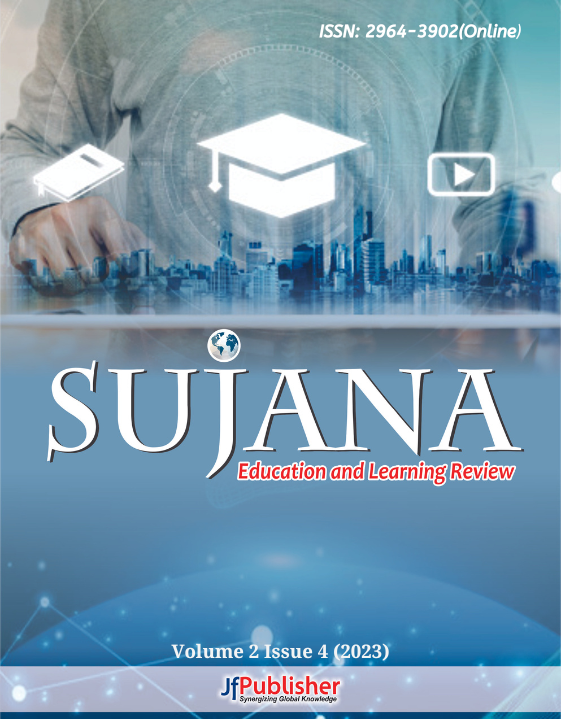ENHANCEMENT OF PROBLEM-SOLVING SKILL USING IDEAL PROBLEM-SOLVING LEARNING MODEL
Al-Irsyad Elementary School, Banyuwangi
DOI:
https://doi.org/10.56943/sujana.v2i4.461The requirements of 21st century student competencies are getting more complex. One of the skills that must be developed is problem solving skills. The objective of this research is improving problem-solving skills in electricity through IDEAL problem-solving skills. There are five steps in IDEAL, which are (1) identify the problem; (2) define the goal; (3) explore possible solutions, ideas, or strategies; (4) anticipate results and act; and (5) review and learn. The results of the midterm exam in science subjects for the sixth grade of Al-Irsyad elementary school are low. Based on the research results, it indicates that students’ problem solving must be improved. There are 11 students at the insufficient level, 6 students at the sufficient level, 6 students at the good level, and 2 students at the excellent level. This research method used classroom action research. Classroom action research consists of four steps, which are planning, action, observation, and reflection. This research consisted of two cycles. The class average in the first cycle was 85.28. There were 5 students at the less level, 8 students at the sufficient level, 2 students at the good level, and 10 students at the excellent level. The class average in the second cycle was 85.36. There were 5 students at the poor and fair level, 2 students at the good level, and 13 students at the excellent level. The class average was 85.36 and better than the first cycle about 0.6. Therefore, it means that the IDEAL problem solving model is effective in improving students’ problem solving skills.
Keywords: IDEAL Problem-Solving Skill Science Learning
Astuti, A. P., Aziz, A., Sumarti, S. S., & Bharati, D. A. L. (2019). Preparing 21st Century Teachers: Implementation of 4C Character’s Pre-Service Teacher through Teaching Practice. Journal of Physics: Conference Series, 1233(1), 012109. https://doi.org/10.1088/1742-6596/1233/1/012109
Damopolii, I., Nunaki, J. H., & Supriyadi, G. (2018). Effect of Problem Solving Learning Model on Students Achievement. Journal of Education Research and Evaluation, 2(1). https://doi.org/10.23887/jere.v2i1.12558
Fusaro, M., & Smith, M. C. (2018). Preschoolers’ inquisitiveness and science-relevant problem solving. Early Childhood Research Quarterly, 42, 119–127. https://doi.org/10.1016/j.ecresq.2017.09.002
Ince, E. (2018). An Overview of Problem Solving Studies in Physics Education. Journal of Education and Learning, 7(4), 191–200.
Indriyani, R. W. (2016). Penerapan Model Pembelajaran IDEAL Problem Solving dalam Menyelesaikan Masalah Matematika pada Materi Keliling dan Luas Persegi Panjang dan Persegi bagi Siswa Kelas VII SMP. Jurnal Mathedunesa, 5(2). https://doi.org/https://doi.org/10.26740/mathedunesa.v5n2.p%25p
Islamiah, M. A. U., Trapsilasiwi, D., Oktavianingtyas, E., Kurniati, D., & Murtikusuma, R. P. (2022). Analisis Pemecahan Masalah SPLTV Berdasarkan IDEAL Problem Solving Ditinjau Dari Gaya Belajar Visual-Auditorial-Kinestetik (VAK). Journal of Mathematics Education and Learning, 2(1), 74. https://doi.org/10.19184/jomeal.v2i1.25589
Jayantika, I. G. A. N. T., Parmithi, N. N., & Dyanawati, N. P. A. (2019). Quantum teaching learning model as solution to improve learning activity and mathematics learning outcome. Journal of Physics: Conference Series, 1321(2), 022119. https://doi.org/10.1088/1742-6596/1321/2/022119
KIND, P., & OSBORNE, J. (2017). Styles of Scientific Reasoning: A Cultural Rationale for Science Education? Science Education, 101(1), 8–31. https://doi.org/10.1002/sce.21251
Krajcik, J. (2015). Three-Dimensional Instruction: Using a New Type of Teaching in the Science Classroom. Science and Children, 53(3), 6–8.
Loseby, D. L. (2021). Cognitive Diversity: Solving problems and creating competitive advantage in the commercial environment of procurement and supply chain management.
Maula, N. K. (2020). Analisis Peningkatan Keterampilan Problem-Solving Siswa SMP dalam Pembelajaran Matematika dengan IDEAL Problem-Solving berbasis Game-Based Learning. JURNAL PETIK, 6(2), 71–80. https://doi.org/10.31980/jpetik.v6i2.764
Nayazik, A. (2017). Pembentukan Keterampilan Pemecahan Masalah Melalui Model IDEAL Problem Solving Dengan Teori Pemrosesan Informasi. Kreano, Jurnal Matematika Kreatif-Inovatif, 8(2), 182–190. https://doi.org/10.15294/kreano.v8i2.7163
Ningrum, H. U., Mulyono, M., & Isnarto, I. (2020). Mathematical Connection Ability Based on Self-Efficacy in IDEAL Problem Solving Model Assisted by ICT. Unnes Journal of Mathematics Education Research, 9(2), 139–146.
Nurhayati, T., & Sulistyowati, R. (2022). Using Microsoft Sway in Improving Online Learning: A Case of The Fourth Graders of SDN Bubutan III/71 Surabaya. ACITYA WISESA (Journal of Multidisciplinary Research), 1(3), 94–106.
Priemer, B., Eilerts, K., Filler, A., Pinkwart, N., Rösken-Winter, B., Tiemann, R., & Zu Belzen, A. U. (2020). A framework to foster problem-solving in STEM and computing education. Research in Science & Technological Education, 38(1), 105–130. https://doi.org/10.1080/02635143.2019.1600490
Prilia, A. H., Irianto, S., & Sriyanto, S. (2021). Bahan Ajar Tematik Berbasis Kompetensi Peserta Didik di Abad 21. Jurnal Ilmiah Kontekstual, 2(2), 69–76.
Ratumanan, T. G., & Ayal, C. S. (2020). Introduction to Problem Solving Based Learning Model. Proceedings of the 1st International Conference on Mathematics and Mathematics Education (ICMMED 2020), 497–503.
Rosyada, M. I., & Wibowo, S. E. (2023). Analysis of Mathematics Problem-Solving Ability Based on Ideal Problem-Solving Steps Given Student Learning Styles. AKSIOMA: Jurnal Program Studi Pendidikan Matematika, 12(1), 1332. https://doi.org/10.24127/ajpm.v12i1.6880
Sunarti, I., & Ristiani, N. (2018). Pengaruh Penerapan Model Pembelajaran Problem Solving berbasis Mind Mapping terhadap Kemampuan Berpikir Kritis Siswa (Studi Eksperimen pada Siswa Kelas VIII Mata Pelajaran IPS Terpadu di SMP Negeri 1 Kuningan). Equilibrium: Jurnal Penelitian Pendidikan Dan Ekonomi, 14(02), 18. https://doi.org/10.25134/equi.v15i01.1037
Ulya, H. (2016). Profil Kemampuan Pemecahan Masalah Siswa Bermotivasi Belajar Tinggi Berdasarkan Ideal Problem Solving. Jurnal Konseling Gusjigang, 2(1).
Wijayanto, R., & Santoso, R. H. (2018). Pengembangan Bahan Ajar Matematika dengan Pendekatan Problem Solving berorientasi pada Kemampuan Pemecahan Masalah. Jurnal Pedagogi Matematika, 7(3). https://doi.org/https://doi.org/10.21831/jpm.v7i3.11177
Winarti, D. (2017). Kemampuan Pemecahan Masalah Siswa dalam Menyelesaikan Soal Cerita berdasarkan Gaya Belajar pada Materi Pecahan di SMP. Jurnal Pendidikan Dan Pembelajaran Khatulistiwa, 6(6). https://doi.org/https://dx.doi.org/10.26418/jppk.v6i6.20462

